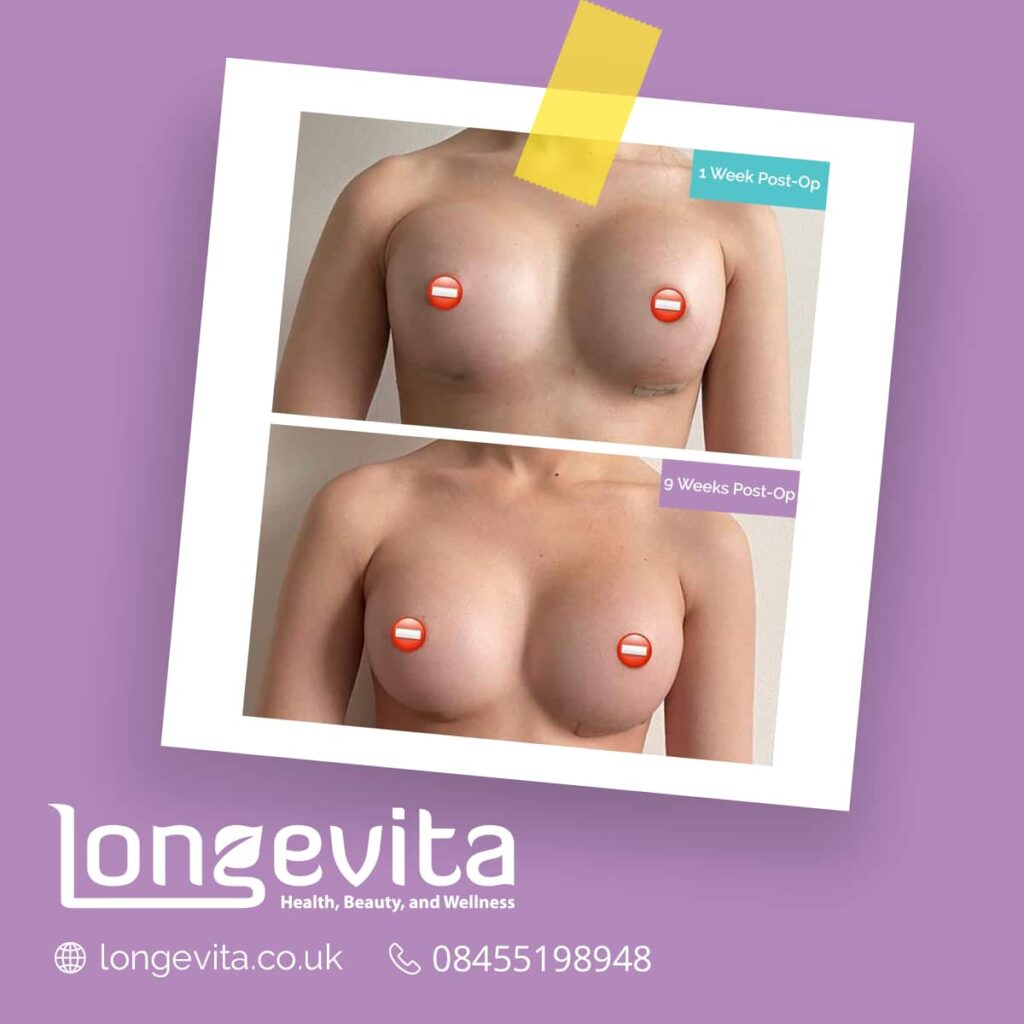Symmetry affects the cosmetic appearance of the breasts. Many women undergo breast surgery to correct asymmetry. Therefore, it can be concerning to see asymmetry even after breast augmentation surgery. Fortunately, most of the time, it’s nothing to worry about. This is because it is temporary.
On the other hand, there may be instances in which uneven breasts may be a result of some post-op complications. In that case, asymmetry may simply be a symptom of a larger problem. You should be aware of the different causes of breast asymmetry so that you know when to seek medical attention.
Why Is One Breast Bigger Than the Other After Augmentation?
Breast asymmetry refers to the differences in the shape, size and projection of the two breasts. Your breasts can also look uneven if the nipples are not in a single plane. And this isn’t something that can be easily ignored, meaning it’s quite noticeable. There are several reasons why breasts may appear asymmetrical after breast augmentation:
Swelling
Swelling is normal and expected after breast augmentation. It’s part of the healing process. This swelling is one of the main reasons why breasts look uneven for some time after the surgery.

There’s no guarantee that swelling in both breasts will subside at the same time. It can go away at different rates, making the breasts look different from each other in size and shape. Usually, it takes about 6 months for the swelling to go away after surgery. By that time, your breasts should start to look symmetrical.
Dropping & Fluffing
Dropping and fluffing refer to the process in which the breast implants drop and settle into place after the augmentation. Over time, the skin and muscle will acclimate to the implant and become relaxed.
This will allow the implant to “drop” down and “fluff” out the lower half of the breasts, making the results look more natural. The implants might appear a bit high after surgery, but within six months, that will no longer be the case.

This dropping and fluffing process won’t necessarily take place at the same time in both breasts. It’s possible for one implant to settle down more quickly than the other.
This is especially true if one implant is bigger than the other (Sometimes the surgeon places different sizes of implants to make the breasts look equal after the surgery. The bigger implants are, the faster they fall). Also, the texture of the implant matters. If it’s smooth, it will slide down more easily than if it’s textured.
Pre-Existing Asymmetry
You should know that even if the human body appears symmetrical, it actually isn’t. Almost always, there’s a degree of asymmetry. If it’s quite significant and noticeable, your surgeon will try to correct it through different surgical interventions (inserting implants of different sizes, removing breast tissue, suctioning fat).
However, this can still leave you with some very minor asymmetry that won’t be noticeable (unless you’re looking too closely). Such pre-existing asymmetries can stem from the underlying muscle and bone structure. And since breast augmentation will not change that, this may be reflected in the final results of the surgery.
Again, it’s not too noticeable. Your surgeon will take this into account before performing the surgery so that the profile, shape, and volume of the implant are chosen accordingly. Still, keep in mind that things like the direction or size of your nipple or the underlying structure of your breasts aren’t something that your surgeon can always control.
Choice of Surgeon
The choice of surgeon matters when it comes to the final results of your surgery. Surgical errors can result in uneven breasts that can only be fixed by another surgery. A surgeon who isn’t experienced or skilled might create different-sized breast pockets for the implants.
The surgeon may also not release the muscle properly when placing the implant underneath it. This can also affect how the implants settle. Also, sometimes, surgeons fill the saline implants after placing the shell inside the breast tissue. If one implant is filled with more fluid than the other, your breasts will look asymmetrical.
Body Changes
Another reason for uneven breasts after breast augmentation is natural changes in the breast tissue and the effects of gravity. They can be exacerbated by weight fluctuation or pregnancy (and breastfeeding).
What Post-Op Complications Cause Asymmetry After Breast Surgery?
If your breasts look uneven after augmentation, it can also be due to some uncommon post-op complications like the following:
Implant Rupture
Breast shape and size changes are signs of implant rupture. Additionally, you may have pain and swelling, among other symptoms. But when this happens (and it affects only one of the breasts), the deflated implant will make one breast look smaller than the other.
The rupture of saline implants is immediately noticeable, but silicone implants can sometimes rupture silently. That is why an MRI or ultrasound is recommended.
Bottoming Out
It is a rare post-op complication in which the implant falls below the crease of the breast. As a result, the incision line shifts forward. This change in the position of the implants can also make them look visibly uneven. You will need revision surgery for this.
Seroma or Hematoma
Both seroma and hematoma are very rare after breast augmentation. A seroma is a buildup of fluid in the surgical area, whereas a hematoma is a buildup of blood. In the case of a seroma, you’ll “feel” liquid underneath the skin, and there will also be swelling, tenderness, and uneven breasts, among other things.
Hematomas, on the other hand, look like bruises. They can also be painful and swollen and make the breasts look uneven. Hematomas and seromas can go away on their own, but sometimes they need surgical drainage.
Implant Rippling
When the ripples on the surface of the implant become visible through the skin, it is known as implant rippling. It’s not always visible, but in more severe cases, the ripples can deform the breasts and make them asymmetrical.
Capsular Contracture
Another fairly uncommon complication after breast augmentation is capsular contracture. It can vary in severity, but when the problem is more serious, it can cause pain and tenderness. The breasts can even get deformed and uneven. Usually, it requires revision surgery as well.
How Can You Make Your Breasts Even After Surgery?
To help your breast implants settle in, you’ll be advised to massage your breasts for 2-3 minutes before bedtime for the first two months.
To massage the breasts, cup your hand over each breast, pressing downward and then upward. Apply gentle pressure to each breast by pushing inside and outside with an open hand. You can increase the pressure as you progress. The following are some massage techniques you can use:
Downward Massage
- Remove your bra and place both hands just above the nipple on your right breast.
- Gently push the implant downward while pulling your breast tissue upward.
- Hold this position for at least 30 seconds.
- Repeat on your left breast.
Upward Massage
- Take off your bra and cup the palm of your left hand under your right breast’s nipple; squeeze the implant upwards.
- Move the implant as high as you can within the implant pocket while alternating between your left and right hands.
- Hold the implant in place for at least 30 seconds after it reaches the top of the pocket.
- Repeat with your right hand underneath your left breast.
Medial Massage
- Remove your bra and cup your hands under and to the side of each breast (or cross your arms and place the left hand outside the right breast and the right hand outside the left breast).
- Push your implants gently toward the midline of your chest until they touch, and then pull.
- Hold this position for at least 30 seconds.
How To Surgically Fix Uneven Breasts After Augmentation?
Depending on the cause of the asymmetry, your surgeon may recommend one or more of the following:
- Replace the implant in the smaller breast with a bigger one.
- Remove breast tissue from the larger boob to make it smaller.
- Inject fat into the smaller boob or remove fat from the larger one.
Your surgeon may also recommend a combination of these treatment options, but it depends on your individual case.
Conclusion
If one of your breasts looks smaller than the other one after surgery, you shouldn’t panic. Post-op swelling is the main reason why many people end up with uneven breasts for a few months. Meanwhile, your implants are also settling into the breast pocket, which can take time. However, you can rest assured that this kind of asymmetry will eventually go away.
But you need to be careful about any unevenness caused by post-op complications. It’s usually accompanied by other symptoms, so you need to keep an eye out for them. If you think you are not recovering normally, don’t hesitate to contact your surgeon.

